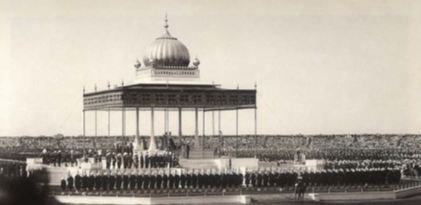Colonialism and the City - Worksheets
CBSE Worksheet 01
Ch-6 Colonialism and the City
Ch-6 Colonialism and the City
- Over 100,000 Indian princes and British officers gathered at this place. In the image given. What was the occasion for this Durbar?

- The Coronation Durbar of King George V
- The announcement that the East India Company was abolished
- Announcement of the end of British rule in India
- Announcement of India's first Prime Minister
- In which year did Delhi became the capital of British India?
- 1931
- 1947
- 1941
- 1911
- What term from the list given bolow can be given to the rebirth of art and living. It is often described as a period of high creativity.
- Renaissance
- De-urbanisation
- Globalisation
- Urbanisation
- From the following list of options, what is a Street with a dead end called?
- Cul-de-sac
- Dargah
- Idgah
- Khangah
- Where did the British in Delhi live after the rebellion was quelled?
- In the Civil Lines
- In New Delhi
- In Red Fort
- In the walled city
- Match the following:
(i) Kingsway (a) 1947 (ii) Edward Lutyens (b) Rajpath (iii) The Partition (c) Delhi (iv) Nizamuddin Auliya (d) Architect - Fill in the blanks:
- The first structure to successfully use the dome was called the ______.
- The two architects who designed New Delhi and Shahjahanabad were ______ and ________.
- The British saw overcrowded spaces as _______ and _________.
- In 1888 an extension scheme called the _______ was devised.
- State whether each of the following statements is True or False.
- The Central dome of the Viceory’s Palace was copied from the Mughal architecture.
- New Delhi took at least 50 years to Build.
- The population of Delhi Drew all of a sudden after partition.
- Name the cities that were de – urbanized in the 19th century.
- Why did the British learn Urdu/Persian culture?
- Why were the main streets of Chandni Chowk and Faiz Bazar made broad?
- Before 1857, developments in Delhi were somewhat different from those in other Colonial cities. How?
- How British made people of Delhi to forget its Mughal Past?
CBSE Worksheet 01
Ch-6 Colonialism and the City
Ch-6 Colonialism and the City
Answer
- The Coronation Durbar of King George V
Explanation: In 1911, when King George V was crowned in England, a Durbar was held in Delhi to celebrate the occasion. The decision to shift the capital of India from Calcutta to Delhi was announced at this Durbar.In the Coronation Durbar of 12 December, 1911 Over 100,000 Indian princes and British officers and soldiers gathered at the Durbar.
- The Coronation Durbar of King George V
- 1911, Explanation: In 1803, the British gained control of Delhi after defeating the Marathas. Since the capital of British India was Calcutta, the Mughal emperor was allowed to continue living in the palace complex in the Red Fort. The modern city as we know it today developed only after 1911 when Delhi became the capital of British India.
- Renaissance, Explanation: The establishment of the Delhi College in 1792 led to a great intellectual flowering in the sciences as well as the humanities, largely in the Urdu language. Many refer to the period from 1830 to 1857 as a period of the Delhi renaissance. Renaissance is literally rebirth of art and learning. It is a term often used to describe a time when there is great creative activity.
- Cul-de-sac, Explanation: Delhi during Shah Jahan’s time was also an important centre of Sufi culture. It had several dargahs, khanqahs and idgahs.Dargah isthe tomb of a Sufi saint. Cul-de-sac is a Street with a dead end.
- In the Civil Lines, Explanation: The British in Delhi live after the rebellion was quelled was in the Civil Lines.
- Kingsway - (b) Rajpath
- Edward Lutyens - (d) Architect
- The Partition of India - (a) 1947
- Nizamuddin Auliya - (c) Delhi
- The first structure to successfully use the dome was called the central dome.
- The two architects who designed New Delhi and Shahjahanabad were Edward Lutyens and Herbert Baker.
- The British saw overcrowded spaces as unhygienic and unhealthy.
- In 1888 an extension scheme called the Lahore Gate Improvement Scheme was devised.
- False: The central dome of the Viceroy’s Palace was copied from the Buddhist stupa at Sanchi.
- False: New Delhi took nearly 20 years to build.
- True
- Surat, Machipatnam and Seringapatam.
- The British learned to enjoy Urdu/Persian culture and poetry and to participate in local festivals.
- They were made broad for royal processions to pass.
- In Presidency cities, Bombay, Madras and Calcutta, the living spaces of Indians and the British were sharply separated.
- Indian lived in the ‘black’ areas, while the British lived in well laid out ‘white’ areas. But in Delhi, in the first half of the 19th century, the British lived along with the wealthier Indians in the Walled City.
- The British learned to enjoy Urdu/Persian culture and poetry and took part in local festivals.
- After the revolt of 1857, Britishers embarked on a mission to rid the city of its Mughal past. They razed several palaces, closed down gardens and built barracks for troops in their place.
- For security reasons, the area around the Red Fort was completely cleared of gardens, pavilions, and mosques.
- Mosques, in particular, were either destroyed or put to other uses.
- For instance, the Zinat-al-Masjid was converted into a bakery.
- No worship was allowed in the Jama Masjid for five years.
- One-third of the city was demolished and its canals were filled up.
- In the 1870s, the Western walls of Shahjahanabad were broken to establish the railway and to allow the city to expand beyond the walls.
